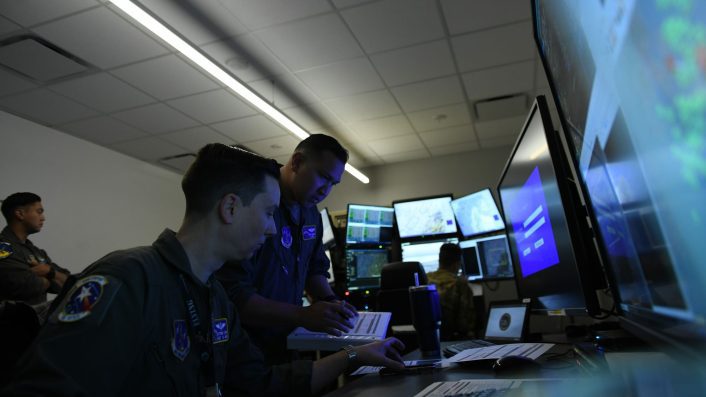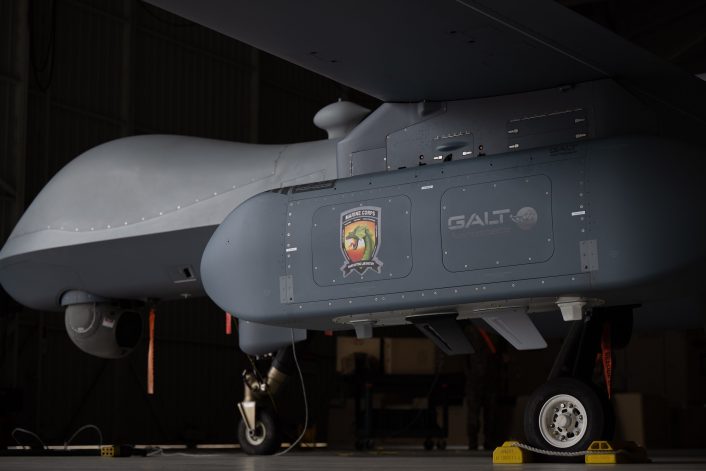The exercise focused on maritime operations to reflect the growing need for MQ-9 capabilities in the Indo-Pacific region, said the Air Force.
The recent Exercise Reaper Smoke, held late in April at March Air Reserve Base in California, saw U.S. Air Force Reserve and California Air National Guard – whose 163rd Attack Wing hosted the exercise – using their MQ-9A Reaper Remotely Piloted Aircraft (RPA) in drills focused on maritime operations. Implying a clear reference to a possible future high-end war with China in far-east Asia, the statement said the exercise “reflected the growing need for MQ-9 capabilities in the Indo-Pacific region” and the Reaper’s “growing importance in meeting challenges posed by near-peer competitors in the Pacific.”
On May 23, GA-ASI highlighted on X the MQ-9A Reaper’s adaptability and operational flexibility, which would be useful to meet the growing need for long-range maritime surveillance and reconnaissance in the Indo-Pacific.
The Air Force’s previous exercises with its Reapers only hinted about the service repurposing the RPA’s employment for an Indo-Pacific role. These include Holloman AFB’s three-week Project Iron Agility in mid-March. The USAF’s Reaper was also tested logistically to operate from non-paved, austere runways during Exercise Reaper Castillo in late 2024.
However, in Reaper Smoke 2025, the role in the Indo-Pacific with maritime operation was explicitly stated. The Reaper’s maritime role is not really a surprise, as a sea-centric service like the U.S. Marine Corps has been open about using its Reapers in a sea war with China through exercises and acquisitions.
MQ-9A Reaper® continues to evolve, making its adaptability and operational flexibility even more relevant for @AirNatlGuard and @USAFReserve emerging needs. The evolving Indo-Pacific security landscape highlights a growing need for MQ-9’s versatility for long-range maritime… pic.twitter.com/xexi01T7Fj
— General Atomics Aeronautical Systems, Inc (GA-ASI) (@GenAtomics_ASI) May 22, 2025
Focus on Reaper’s use in Indo-Pacific’s maritime theater
Noting how this iteration of Reaper Smoke 2025 “challenged aircrews in a new domain [like] the maritime environment,” the release from March ARB further stated that the MQ-9 Reaper “traditionally operates under U.S. Central Command in southwest Asia,” while this “exercise focused on sea operations.”
The reference to CENTCOM operations brings into focus the loss of 12 MQ-9 Reapers, costing $30 million apiece, to the Houthis since the start of the war in Gaza, according to Stars and Stripes. That challenging Western coalition deployment has attracted intense attention over the formidable threats to sophisticated systems posed by the non-state actor.
“The exercise presented new challenges and directly addressed the growing demand for MQ-9 capabilities in maritime domain awareness and power projection in the Pacific,” the release said. Aircrews and support personnel competed in the annual exercise that “tested tactics, techniques and procedures, as well as critical thinking, amid increased demand for the MQ-9.”
“The evolving security landscape, particularly in the Indo-Pacific, has highlighted the platform’s versatility for long-range maritime surveillance and reconnaissance,” mentioned the press release. “This collaboration is crucial for developing interoperability in the complex Indo-Pacific environment.”


Brig. Gen. Keith A. Chikasawa, assistant adjutant general of California ANG, said in the release that “Combatant commanders are asking for this platform.” This “underscored the MQ-9’s growing importance in meeting challenges posed by near-peer competitors in the Pacific.”
During Reaper Smoke, Airmen had a chance to “creatively employ tools and mechanisms in a total-force environment alongside other MQ-9 operators,” mentioned the statement, adding that “Innovation is key when presented with real-world scenarios.” Additionally, this allowed Airmen to “prepare for the challenges of a rapidly evolving technological landscape, including the vast distances and unique operational requirements of the Indo-Pacific theater.”
The Commander of the 196th Attack Squadron, Lt. Col. Gregory Schonberger, said various MQ-9 Reaper crews were able to “hone and refine tactics, techniques and procedures,” ensuring they are “ready for rapidly evolving global challenges.”
The images released with the statement did not show any of the Reapers, but only captured the competing crews at work in the MQ-9’s ground control stations. The captions say that the teams were judged on “crew utilization, time on target, tactics and key target identification during a 30-minute tactical scenario to mimic maritime surface warfare.”
More than 200 MQ-9 Reaper Airmen from across the country joined Your Cal Guard’s 163rd Attack Wing for Reaper Smoke 2025 earlier this month. This year’s training pushed aircrews into the maritime domain — a growing priority for Pacific stability and national defense.… pic.twitter.com/jyqxVNoS2S
— The California Military Department (@TheCalGuard) May 15, 2025
It is unclear what type of missions the Reapers performed as part of the maritime surface warfare, although this could be an extremely rare, if not the first, envisioning of Air Force Reapers in anti-ship fire roles. So far, only GA-ASI-owned MQ-9B SeaGuardian and the U.S. Marine Corps’ MQ-9A Reaper Block 5s are oriented for naval warfare, but they can also act in Anti-Submarine Warfare, C-UAS and communications and targeting relay roles.
FINN Pod and the Air Force’s ‘relaying’ Reapers in the Pacific
Images on DVIDS, taken on May 4, 2025 and posted on May 20, showed an Air Force MQ-9A Reaper, again with the California ANG’s 163rd Attack Wing, carrying a Fused Integrated Naval Network (FINN) pod in support of the Joint Exercise SoCal. The caption said the FINN pod is developed with the U.S. Marine Corps Warfighting Laboratory (MCWL) and Global Air Logistics and Training (GALT), and “enhances interoperability and situational awareness between U.S. Navy, Marine Corps and Joint Force platforms.”
Interestingly, the Marines’ SkyTower II (STII) communication relay pods are also developed by GALT. The RDESS/SOAR (Reaper Defense Electronic Support System/Scalable Open Architecture Reconnaissance), that the USMC officially acknowledged in 2024, was also tested on the Air Force’s Reapers in 2021, suggesting the Air Force and the USMC had been integrating their Reaper upgrades for the Indo-Pacific.
The FINN pod was first publicized by GALT (Global Air and Logistics Training) in Jun. 2021 in a “successful government customer developmental test” at MCB Camp Pendleton in California. It provides the “Naval Force (US Navy and US Marine Corps) with the ability to share Situational Awareness (SA) between incompatible platforms with emphasis on high priority LPI/LPD (Low-Probability of Intercept/Detection and assured links.”
Over the course of two weeks and 24 flight hours on a Saab-340 aircraft, “the GALT team demonstrated the airborne FINN Prototype communication gateway capabilities between ground-based communication nodes and the podded system.” The pod has capabilities like “multi-waveform cross banding (L-16, TTNT, BE CDL, IBS, and TSM-X) monitoring, management and control of the payload, track correlation, data fusion, and edge networking communication to and from remote/disadvantaged users and command elements.”


Marines and USAF Reapers in the Indo-Pacific
A GA-ASI concept video of a “STOL mission kit” from Feb. 2023 showed an MQ-9B SeaGuardian with the markings of VMU-1 (Marine Unmanned Aerial Vehicle Squadron-1). GA-ASI then recently tested the Gray Eagle STOL (Short Take-Off Landing) variant in a Counter-Unmanned Aerial Systems (C-UAS) trial firing Hellfire missiles and APKWS II rockets.
The company is also testing a STOL kit in a wind tunnel for the MQ-9B SeaGuardian and SkyGuardian drones. We analyzed that the STOL kit could be a rapidly strappable system for the existing MQ-9Bs, while the Gray Eagle’s C-UAS test might have served to quickly prove its STOL wing before its kitted form is tested on the MQ-9B for carrier operations.
The Marine Corps MQ-9 Reaper test squadron, UX-24, at Pax River has successfully integrated the first SkyTower II pod, enhancing communication and ISR capabilities. These upgrades will support critical missions in 2026 and beyond. pic.twitter.com/9Ze8ITZHwm
— NAVAIR (@NAVAIRNews) March 10, 2025
Thus, the possibility of Marine Reapers receiving the STOL kit cannot be ruled out, since Littoral Marines could operate them from the small features in the South China Sea. Specifically, the STOL kit, the Reaper’s ISR features and the STII and FINN pods on the Marine and Air Force MQ-9s could help quietly trade information on PLA Navy warships, shorten or lengthen ‘kill chains’. This capability could be used by the littoral Marines on South China Sea islands, Air Force F-15 EXs and F-35As and Marine F-35Bs firing the NMESIS, Joint Strike Missile or the AGM-158C LRASM (Long-Range Anti-Ship Missile), respectively, on PLAN vessels.



